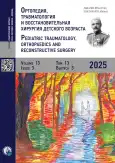儿童远节指骨撕脱性骨折手术治疗方法的分析
- 作者: Gordienko I.I.1,2, Slukina A.E.1, Tsap N.A.1,2
-
隶属关系:
- Ural State Medical University
- Children’s City Clinical Hospital No. 9, Yekaterinburg
- 期: 卷 13, 编号 3 (2025)
- 页面: 247-255
- 栏目: Clinical studies
- URL: https://bakhtiniada.ru/turner/article/view/349946
- DOI: https://doi.org/10.17816/PTORS683118
- EDN: https://elibrary.ru/FMXDGR
- ID: 349946
如何引用文章
详细
论证。撕脱性关节内骨折约占儿童远节指骨损伤的18%。截至目前,针对这类损伤的外科治疗尚无统一的途径。作为开放复位的替代方法,Ishiguro技术具有潜在优势,但其在儿童创伤学中的应用经验仍然有限。
目的:通过对比分析开放复位伴外周骨片克氏针固定与Ishiguro技术下的微创复位及骨接合效果,确定儿童远节指骨关节内撕脱性骨折的最佳外科治疗方案。
方法。在Children’s City Clinical Hospital No. 9创伤科第1和第2部门开展前瞻性队列研究,地点为Yekaterinburg。纳入29名儿童,均为关节面移位超过1/3的远节指骨关节内撕脱性骨折患者。研究组(n=15)采用Ishiguro微创复位与骨接合方法;对照组(n=14)采用开放复位与克氏针固定外周骨片。术后第3天和第7天对针道局部炎症反应进行宏观评估。去除内固定后第 1、2、4 周使用量角器测量远端指间关节活动度。
结果。研究组远端指间关节活动度恢复显著优于对照组:去除内固定后1周分别为17.80±7.43°vs 7.79±3.40°(p<0.001);2周为 57.47±13.11° vs 28.86±12.09°(p<0.001);4周为89 [85; 90]° vs 78.50 [77.25; 83.00]°(p<0.001)。在术后第3天和第7天对钢针植入部位进行宏观评估时,两组在针道局部炎症反应方面未见统计学差异(p>0.05)。所有病例均实现骨折愈合。对照组1例出现外周骨片碎裂的不良事件。
结论。Ishiguro骨接合技术具有良好的技术可重复性、微创性和优良的功能恢复效果,可推荐作为儿童远节指骨关节内撕脱性骨折的首选治疗方法。
作者简介
Ivan I. Gordienko
Ural State Medical University; Children’s City Clinical Hospital No. 9, Yekaterinburg
编辑信件的主要联系方式.
Email: ivan-gordienko@mail.ru
ORCID iD: 0000-0003-3157-4579
SPIN 代码: 5368-0964
MD, Cand. Sci. (Medicine), Assistant Professor
俄罗斯联邦, Yekaterinburg; YekaterinburgAnastasia E. Slukina
Ural State Medical University
Email: anast.slukina@gmail.com
ORCID iD: 0009-0000-3431-7813
SPIN 代码: 5149-4840
俄罗斯联邦, Yekaterinburg
Natalia A. Tsap
Ural State Medical University; Children’s City Clinical Hospital No. 9, Yekaterinburg
Email: tsapna-ekat@rambler.ru
ORCID iD: 0000-0001-9050-3629
SPIN 代码: 7466-8731
MD, Dr. Sci. (Medicine), Professor, Honored Doctor of the Russian Federation
俄罗斯联邦, Ekaterinburg; Ekaterinburg参考
- Abzug JM, Dua K, Bauer AS, et al. Pediatric phalanx fractures. J Am Acad Orthop Surg. 2016;24(11):e174–e183. doi: 10.5435/JAAOS-D-16-00199
- Chen AT, Conry KT, Gilmore A, et al. Outcomes following operative treatment of adolescent mallet fractures. HSS J. 2018;14(1):83–87. doi: 10.1007/s11420-017-9563-7
- Lankachandra M, Wells CR, Cheng CJ, Hutchison RL. Complications of distal phalanx fractures in children. J Hand Surg Am. 2017;42(7):574.e1–574.e6. doi: 10.1016/j.jhsa.2017.03.042
- Khera B, Chang C, Bhat W. An overview of mallet finger injuries. Acta Biomed. 2021;92(5):e2021246. doi: 10.23750/abm.v92i5.11731
- Nashi N, Sebastin SJ. A pragmatic and evidence-based approach to mallet finger. J Hand Surg Asian Pac Vol. 2021;26(3):319–332. doi: 10.1142/S2424835521400063 EDN: RAYFCW
- Lin JS, Samora JB. Surgical and nonsurgical management of mallet finger: a systematic review. J Hand Surg Am. 2018;43(2):146–163.e2. doi: 10.1016/j.jhsa.2017.10.004
- Lin JS, Samora JB. Outcomes of splinting in pediatric mallet finger. J Hand Surg Am. 2018;43(11):1041.e1–1041.e9. doi: 10.1016/j.jhsa.2018.03.037
- Niechajev IA. Conservative and operative treatment of mallet finger. Plast Reconstr Surg. 1985;76(4):580–585. doi: 10.1097/00006534-198510000-00019
- Wang WC, Hsu CE, Yeh CW, et al. Functional outcomes and complications of hook plate for bony mallet finger: a retrospective case series study. BMC Musculoskelet Disord. 2021;22(1):281. doi: 10.1186/s12891-021-04163-2 EDN: FZEZCH
- Rocchi L, Fulchignoni C, De Vitis R, et al. Extension block pinning vs single Kirshner wiring to treat bony mallet finger: a retrospective study. Acta Biomed. 2022;92(S3):e2021535. doi: 10.23750/abm.v92iS3.12484
- Janarv PM, Wikström B, Hirsch G. The influence of transphyseal drilling and tendon grafting on bone growth: an experimental study in the rabbit. J Pediatr Orthop. 1998;18(2):149–154.
- Hara A. Conservative treatment of chronic mallet fracture non-union after failed pin fixation. Asp Biomed Clin Case Rep. 2020;3(1):25–28. doi: 10.36502/2020/ASJBCCR.6181
- Gordienko II, Tsap NA, Kutepov SM. Treatment of fractures of the main phalanx of the fingers in children. Pediatric Traumatology, Orthopaedics and Reconstructive Surgery. 2022;10(3):247–253. doi: 10.17816/PTORS108751 EDN: KIQVXZ
- Segond P. Note on a case of tearing off the insertion point of the small phalangeal laguettes of the extensor of the little finger, by force bending of the phalangette on the phalagina. The Medical Progress. 1880;VIII:534–535. (In French.)
- Shankar NS, Goring CC. Mallet finger: long-term review of 100 cases. J R Coll Surg Edinb. 1992;37(3):196–198.
- Wehbé MA, Schneider LH. Mallet fractures. J Bone Joint Surg Am. 1984;66(5):658–669.
- Volkova YS, Rodomanova LA. Management of mallet finger: current status (review). Traumatology and Orthopedics of Russia. 2022;28(4):183–192. doi: 10.17816/2311-2905-1996 EDN: ZDEMEA
- Ishiguro T, Itoh Y, Yabe Y, Hashizume N. Extension block with Kirschner wire for fracture dislocation of the distal interphalangeal joint. Tech Hand Up Extrem Surg. 1997;1(2):95–102. doi: 10.1097/00130911-199706000-00005
- Usami S, Kawahara S, Kuno H, et al. A retrospective study of closed extension block pinning for mallet fractures: analysis of predictors of postoperative range of motion. J Plast Reconstr Aesthet Surg. 2018;71(6):876–882. doi: 10.1016/j.bjps.2018.01.041
- Capkin S. Extension-block pinning to treat bony mallet finger: is a transfixation pin necessary? Ulus Travma Acil Cerrahi Derg. 2019;25(3):281–286. doi: 10.5505/tjtes.2018.59951
- Perez-Lopez LM, Perez-Abad M, Suarez Merchan MA, Cabrera Ortiz DA. Reverse Ishiguro extension block technique as an alternative for irreducible osseous mallet finger. Tech Hand Up Extrem Surg. 2024;28(2):62–66. doi: 10.1097/BTH.0000000000000465 EDN: GJVPKD
- Gergő J, Dániel K, Zsolt O. The Ishiguro technique for the treatment of mallet finger fracture in adolescent. Nov Tech Arthritis Bone Res. 2017;1(1):555552. doi: 10.19080/NTAB.2017.01.555552
- Gordienko II, Slukina AE, Shilina SA, Tsap NA. Comparative analysis of the results of treatment for metacarpal neck fractures in children with antegrade and retrograde Kirschner wire fixation. Ural Medical Journal. 2024;23(5):32–42. doi: 10.52420/umj.23.5.32 EDN: DDDPEH
- Acciaro AL, Gravina D, Pantaleoni F, et al. Retrospective study of Ishiguro’s technique for mallet bone finger in children: long-term follow-up and analysis of predictors in outcomes. Int Orthop. 2024;48(6):1501–1506. doi: 10.1007/s00264-024-06162-z EDN: FDZJKS
补充文件











